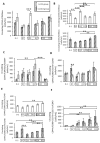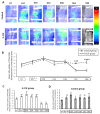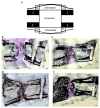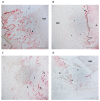Systemic Administration of G-CSF Accelerates Bone Regeneration and Modulates Mobilization of Progenitor Cells in a Rat Model of Distraction Osteogenesis
- PMID: 33800710
- PMCID: PMC8037338
- DOI: 10.3390/ijms22073505
Systemic Administration of G-CSF Accelerates Bone Regeneration and Modulates Mobilization of Progenitor Cells in a Rat Model of Distraction Osteogenesis
Abstract
Granulocyte colony-stimulating factor (G-CSF) was shown to promote bone regeneration and mobilization of vascular and osteogenic progenitor cells. In this study, we investigated the effects of a systemic low dose of G-CSF on both bone consolidation and mobilization of hematopoietic stem/progenitor cells (HSPCs), endothelial progenitor cells (EPCs) and mesenchymal stromal cells (MSCs) in a rat model of distraction osteogenesis (DO). Neovascularization and mineralization were longitudinally monitored using positron emission tomography and planar scintigraphy. Histological analysis was performed and the number of circulating HSPCs, EPCs and MSCs was studied by flow cytometry. Contrary to control group, in the early phase of consolidation, a bony bridge with lower osteoclast activity and a trend of an increase in osteoblast activity were observed in the distracted callus in the G-CSF group, whereas, at the late phase of consolidation, a significantly lower neovascularization was observed. While no difference was observed in the number of circulating EPCs between control and G-CSF groups, the number of MSCs was significantly lower at the end of the latency phase and that of HSPCs was significantly higher 4 days after the bone lengthening. Our results indicate that G-CSF accelerates bone regeneration and modulates mobilization of progenitor cells during DO.
Keywords: G-CSF; bone formation; endothelial progenitor cells; hematopoietic stem/progenitor cells; mesenchymal stromal cells; neovascularization.
Conflict of interest statement
The authors declare no conflict of interest. The funders had no role in the design of the study; in the collection, analyses, or interpretation of data; in the writing of the manuscript, or in the decision to publish the results.
Figures

 represents the latency period, the distraction phase is represented by
represents the latency period, the distraction phase is represented by  , and
, and  represents the consolidation phase. ** p < 0.05, *** p < 0.01. Cytometry assays were performed on 6 G-CSF animals and 4 control animals.
represents the consolidation phase. ** p < 0.05, *** p < 0.01. Cytometry assays were performed on 6 G-CSF animals and 4 control animals.
 represents the latency period,
represents the latency period,  represents the distraction phase and the consolidation phase is represented by
represents the distraction phase and the consolidation phase is represented by  . Planar scintigraphy was performed on 6 control animals and 4 G-CSF animals. ** p < 0.05, *** p < 0.01, **** p < 0.001, ***** p < 0.0001.
. Planar scintigraphy was performed on 6 control animals and 4 G-CSF animals. ** p < 0.05, *** p < 0.01, **** p < 0.001, ***** p < 0.0001.
 represent the latency period, the distraction phase is represented by
represent the latency period, the distraction phase is represented by  , and
, and  the consolidation phase. *** p < 0.01, **** p < 0.001.
the consolidation phase. *** p < 0.01, **** p < 0.001.

Similar articles
-
Mobilization of endothelial progenitor cells in fracture healing and distraction osteogenesis.Bone. 2008 May;42(5):932-41. doi: 10.1016/j.bone.2008.01.007. Epub 2008 Jan 26. Bone. 2008. PMID: 18326482
-
Administration of allogeneic mesenchymal stem cells in lengthening phase accelerates early bone consolidation in rat distraction osteogenesis model.Stem Cell Res Ther. 2020 Mar 20;11(1):129. doi: 10.1186/s13287-020-01635-5. Stem Cell Res Ther. 2020. PMID: 32197646 Free PMC article.
-
Augmenting neovascularization accelerates distraction osteogenesis.Plast Reconstr Surg. 2011 Aug;128(2):406-414. doi: 10.1097/PRS.0b013e31821e6e2e. Plast Reconstr Surg. 2011. PMID: 21788832
-
The role of granulocyte colony-stimulating factor in mobilization and transplantation of peripheral blood progenitor and stem cells.Cytokines Mol Ther. 1995 Dec;1(4):249-70. Cytokines Mol Ther. 1995. PMID: 9384679 Review.
-
[Collection of hematopoietic progenitor cells from healthy donors].Acta Med Croatica. 2009 Jun;63(3):237-44. Acta Med Croatica. 2009. PMID: 19827352 Review. Croatian.
Cited by
-
Equine Mesenchymal Stem/Stromal Cells Freeze-Dried Secretome (Lyosecretome) for the Treatment of Musculoskeletal Diseases: Production Process Validation and Batch Release Test for Clinical Use.Pharmaceuticals (Basel). 2021 Jun 10;14(6):553. doi: 10.3390/ph14060553. Pharmaceuticals (Basel). 2021. PMID: 34200627 Free PMC article.
-
A new osteogenic protein isolated from Dioscorea opposita Thunb accelerates bone defect healing through the mTOR signaling axis.Bioact Mater. 2023 Apr 23;27:429-446. doi: 10.1016/j.bioactmat.2023.04.018. eCollection 2023 Sep. Bioact Mater. 2023. PMID: 37152710 Free PMC article.
-
Exploring causal correlations between inflammatory cytokines and knee osteoarthritis: a two-sample Mendelian randomization.Front Immunol. 2024 Apr 18;15:1362012. doi: 10.3389/fimmu.2024.1362012. eCollection 2024. Front Immunol. 2024. PMID: 38698846 Free PMC article. Review.
-
Monitoring osseointegration and degradation of Mg-alloy implants through plasma biomarkers of inflammation and bone regeneration.J Tissue Eng. 2025 May 5;16:20417314241290595. doi: 10.1177/20417314241290595. eCollection 2025 Jan-Dec. J Tissue Eng. 2025. PMID: 40336953 Free PMC article.
-
Gold-Induced Cytokine (GOLDIC®) Therapy in the Management of Knee Osteoarthritis: An Observational Study.Cureus. 2023 Sep 29;15(9):e46231. doi: 10.7759/cureus.46231. eCollection 2023 Sep. Cureus. 2023. PMID: 37908900 Free PMC article.
References
-
- Singh M., Vashistha A., Chaudhary M., Kaur G. Biological Basis of Distraction Osteogenesis—A Review. J. Oral Maxillofac. Surg. Med. and Pathol. 2016;28 doi: 10.1016/j.ajoms.2015.05.006. - DOI
MeSH terms
Substances
LinkOut - more resources
Full Text Sources
Other Literature Sources
Medical

